If not, I did it last night while doing the coil relay mod and took some pictures. I'd be happy to write one up for swapping the fuse block, but don't want to waste my time if someone else has already done it. I know this isn't exactly a complicated procedure, but some folks out there just feel better when they have a guide. Especially when dealing with wires.
Announcement
Collapse
No announcement yet.
Fuse block tutorial?
Collapse
X
-
 uudfourty
uudfourty
Fuse block tutorial?
Has anyone done a how-to for the forum on how to swap your glass fuse block for a new spade-style one?
If not, I did it last night while doing the coil relay mod and took some pictures. I'd be happy to write one up for swapping the fuse block, but don't want to waste my time if someone else has already done it. I know this isn't exactly a complicated procedure, but some folks out there just feel better when they have a guide. Especially when dealing with wires.Tags: None
-
That is a great idea
There may already be one I dont ever rememebr seeing one but more "how to's" are very helpful as otherwise it requires quite a bit of (re)search to figure out the best thing to do.
It would be best to have it reviewed for comment , content and clarity then it would be more likely to have lasting value to the forum.
:-D
Posplayr
-
 uudfourty
uudfourty
Ah, of course.Originally posted by posplayr View Post
It would be best to have it reviewed for comment , content and clarity then it would be more likely to have lasting value to the forum.
:-D
Posplayr
I was going to put it on tips and tricks, then let the powers that be decide whether my offering is worthy.
Comment
-
No offense intended
I just do a lot of engineering work and "peer review" is becoming a standard part of the process for document development.
I was considering doing an electrical tutorial as well to supplement the Stator pages. I think Basscliff does a certain amount of editing before posting on his site so that might be the way to go.
Good Luck
Posplayr
Comment
-
 uudfourty
uudfourty -
 maro
maro -
 spyug
spyug
These tutorials that guys like Mr. Bcliff and MrBwringer and others put together are Awesome and invaluable for many, especially newbies. I think they go a long long way to promoting the GS bike and even the sport in general as I'm sure the information provided can translate to other bikes. Kudos to all of them.
Kudos to you too if you can take the time to put something together and contribute it to the common good.
I recently ran across a very good article on making stainless steel brake lines on another board and if I can obtain permission I would like to add a bit to it and publish it here.
Good on ya mate, as Zooks and the boys would say.
Looking forward to your tutorial.
Cheers,
Spyug.
Comment
-
 seuadr
seuadr
Comment
-
 uudfourty
uudfourty
Alright. I've got a literary analysis of Elizabeth Gaskell's North and South and a researched project proposal for Technical and Professional communications to get done this weekend.
Whenever I get finished with THAT crap, I'll get it put together.
Comment
-
 uudfourty
uudfourty
Here she blows.
I've got the whole thing in a .doc and it looks a lot better than on here. I can email it wherever it needs to go, just PM me. It's public property now.
Fuse Block Upgrade and Soldering How To:
Face it, you havenít done enough stuff to your GS yet.
Glass fuses donít handle shock very well, and theyíre just kinda crappy. Thatís why they were replaced with spade fuses in the first place: something better came along.
So why settle for less than the best (because anything less than the best is a felony) for your GS? It treats you well (sometimes) so you should return the favor and upgrade to a spade terminal fuse box.
The work was done on a 1981 GS550L. There canít be too many differences between the models, so weíll assume for now that if your set up it isnít exactly like mine, itíll be pretty close.
Parts:
A Spade Fuse Block and appropriate fuses.
Whatever flavor of terminals are necessary to hook up to your new fuse block. I used female spade terminals.
Wire
Heat Shrink Tubing is nice, but electrical tape will do.
Some crimp butt splices or a soldering iron and rosin core solder.
Spade terminals
Write nuts for testing.
Wiring diagram (just in caseÖ)
In line fuse if your new fuse block has one common hot lead.
1) Safety First
Disconnect the battery from the bike, offer a bit of knuckle skin and Sea Foam to the GS gods as a burnt sacrifice. Pray that they bless your work.
2) Remove the offender
Take off the old block. Not a big deal. Itíll be held on with a couple of screws on the right hand side of the airbox. Unplug it from everything.
Keep in mind what goes where. It might sound hard to do, but if you keep your old glass fuse block laying right next to you, itís not complicated at all. There is a pigtail connector with 4 orange wires (solid orange, orange/red, orange/green, orange/white) and two other red wires to concern yourself with. One red wire comes off of the starter relay, the other comes from the wire harness.
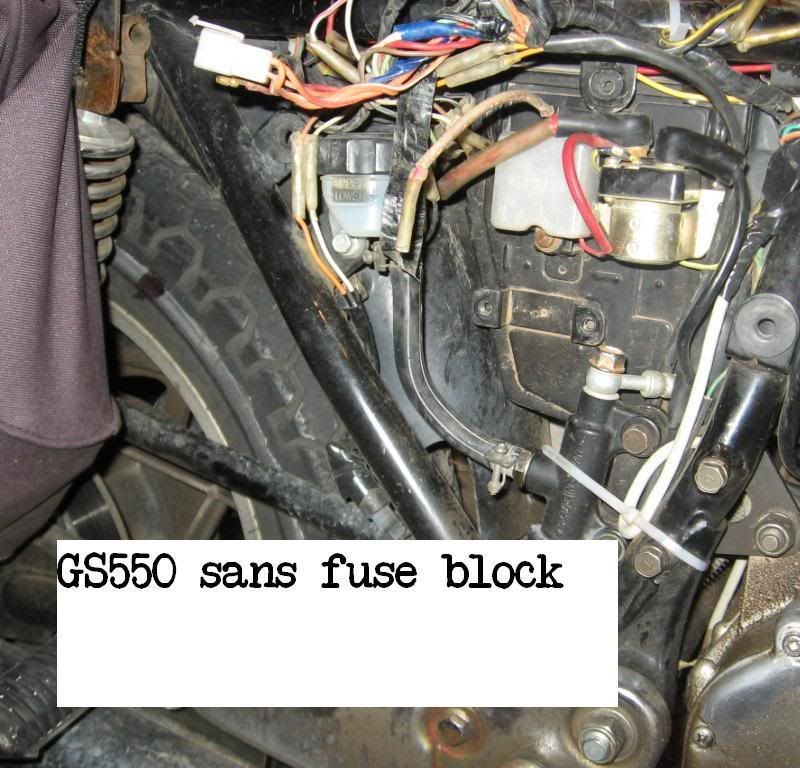
Comment
-
 uudfourty
uudfourty
Now that you’ve got the old fuse block sitting in your lap, pop the back the back cover off:
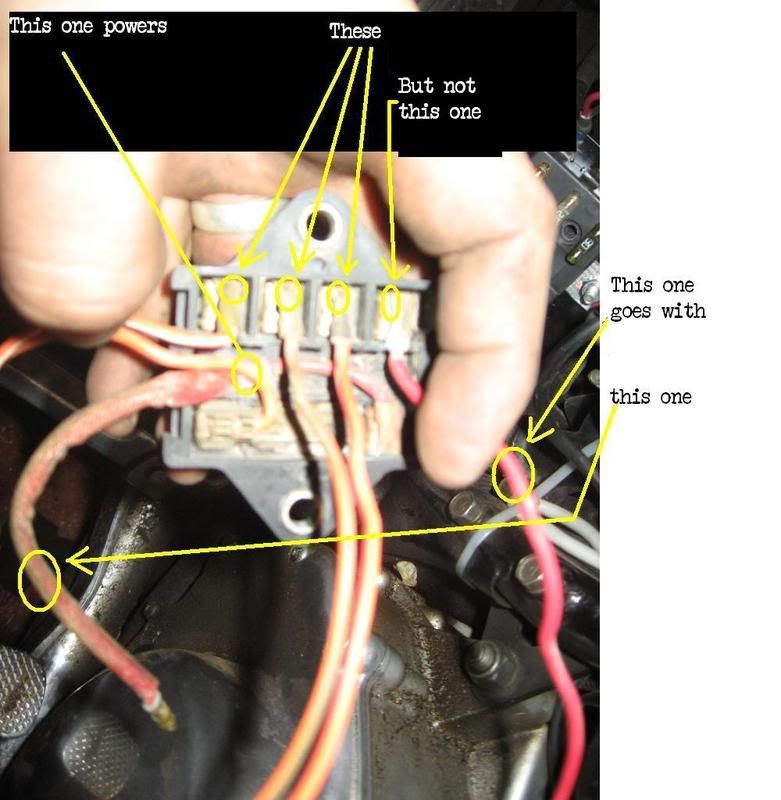
At first glance, it might seem like all of the wires are powered by that one red wire, but that’s not the case. The two red wires run their own circuit and are independent from the orange ones.
3) Don’t forget to write.
Take a piece of paper and jot down the amperage of each fuse and its corresponding wire. For instance:
Orange/Red: 25
Orange/White: 30
Orange/ Green: 30
These numbers are for demonstration purposes only. Refer to your manual for proper amperage, as a PO might’ve installed an improper fuse.
4) Snip Snip
Now you’ll have to prepare your wires for connection to your fuse block.
You can start by getting rid of that bullet-tipped connection.
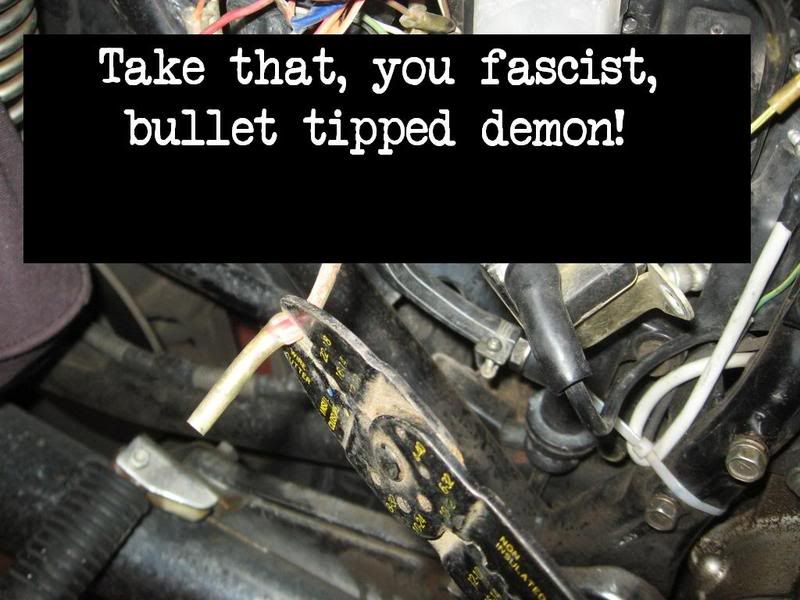
Clip and strip all of the other wires coming off of the bike. Leave enough room on the back of that 4 connection pigtail to be hooked back up later if you, for some reason, decide to use it again.
If you have a fuseblock with all of the fuses being powered by one common lead, then you’ll have to have a separate in-line fuse for that starter solenoid. You’ll only be able to power the orange wires from the fuse block.
If you don’t run the red wires separately try to power all of the fuses with the red wire from the harness, then your indicator lights (neutral, oil pressure) will be on all of the time. The bike will start and run and the lights will come on, but you’ll be jumping around the switch, and you don’t want to do that.
In other words, you don’t want it to look like this:
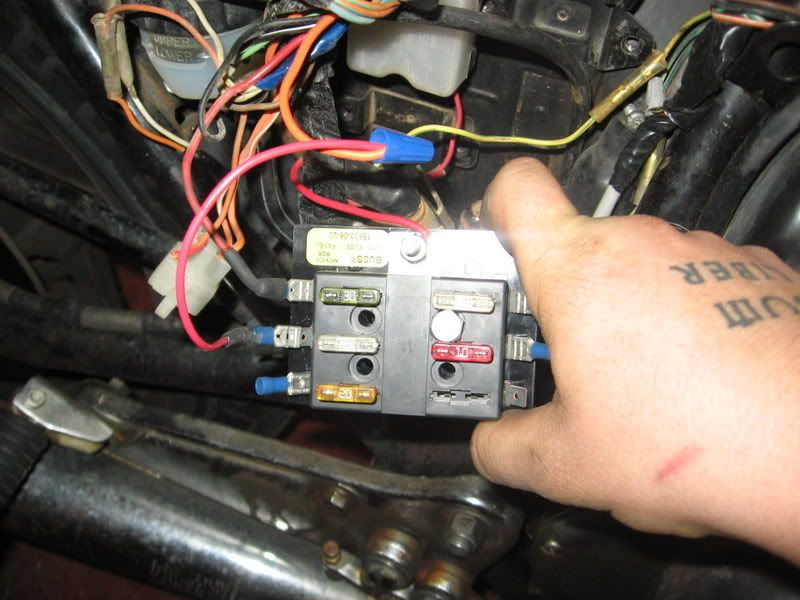 Last edited by Guest; 04-20-2008, 03:57 PM.
Last edited by Guest; 04-20-2008, 03:57 PM.
Comment
-
 uudfourty
uudfourty
If you were fortunate enough to find a fuse block with independent in-and-out slots for each fuse, then all of your fuses can be run from this block. You’ll have to link three of the hot sides together for that solid orange wire and the red for its own circuit.
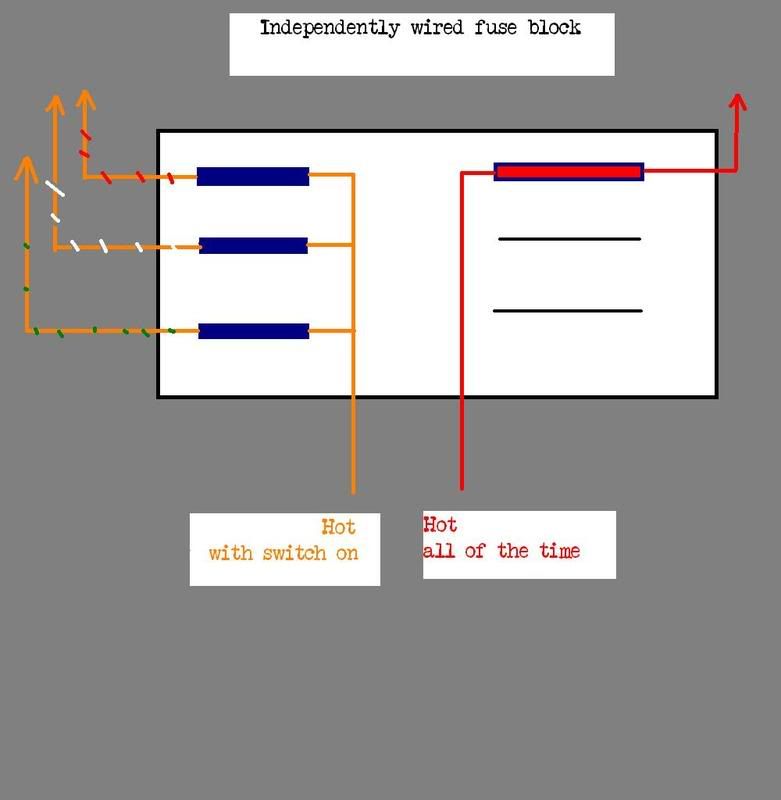
I didn’t have one of those, so I ran the orange ones off of the fuse block, and put an in line fuse in for the starter solenoid (red wires). If you’re doing the coil relay mod and your fuse block is powered off of one common lead rather thane each circuit having its own supply, you’ll need another inline fuse for the relay mod. There are other, better tutorials for the coil relay mod. I’ll not go into detail with that here.
5) Get Crazy With the Wire Nuts
Cut a half foot or so section of wire for each of the outgoing sides of the fuses. Crimp a spade terminal on one end heat shrink each of those half foot sections. Go ahead and connect one end of each of these wires to the fuse block, and wire nut the other end to the corresponding orange wire. Put them on in any order you please, so long as the amperage is correct. That’s why you wrote it all down, right? The wire nuts are for testing purposes and aren’t permanent.
(I had it wired wrong, so ignore where the wires are going, just notice that they’re wire nutted)
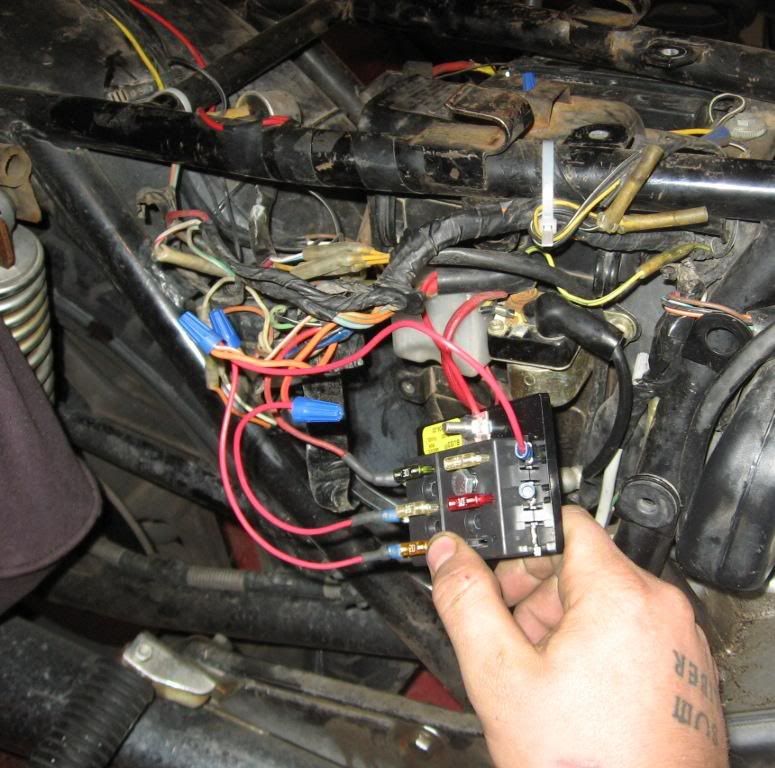
6) In Liners
If you had to run an in line fuse for the starter solenoid (if you had a fuse block with one common lead) then now is the time to hook that up. Find a nice safe place for it to go, put the red wire from the harness into one side of the fuse and the red to the starter solenoid in the other side. Wire nut the connections together for testing purposes.
7) Testing
Re-connect the battery and turn on the bike. Let it set for a second.
No smoke or fire? Good.
Start it.
Make sure all of the lights work.
Turn your bike off and disconnect the battery.
8 )Solder On
Solder your connections.
Rough mount your fuse block wherever you want it to go. Mine (amazingly) mounted up just fine. Most won’t be so lucky. You’ll have to figure out what will work for you, but mine fit right back where the old one came from.
One at a time, undo the wire nuts, cut the wire to the appropriate length, put a piece of heat shrink tubing on one side of the wire and then solder it.
Do this with each wire, mount the block.
9) Go For a Ride
Comment
-
 uudfourty
uudfourty
Not know how to solder?
It ainít hard.
Youíll need a soldering iron and some rosin core wire. You wonít need much solder, but once you get the hang of it, youíll be soldering everything in sight.
If youíre just making a connection between two wires, strip ĺ an inch or more on either side, slide a piece of heat shrink tubing over one half, and perform the following:
Introduce the wires.
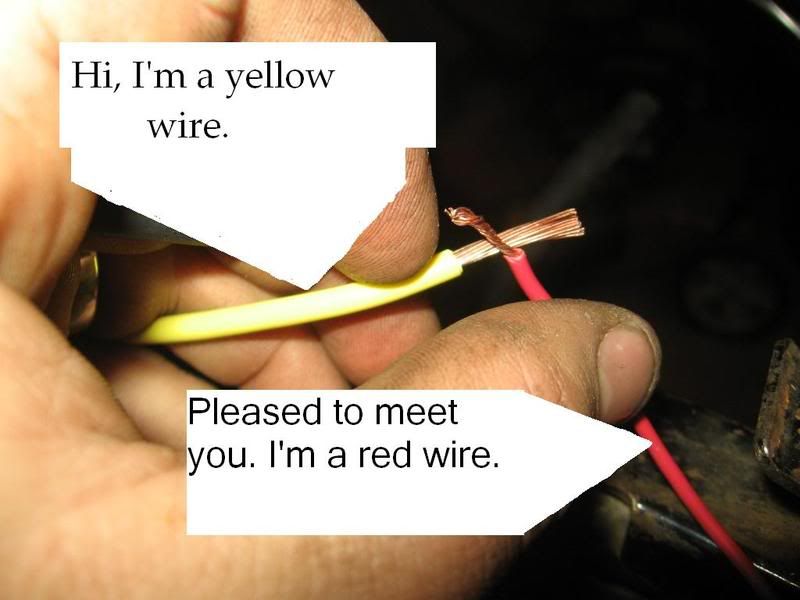
Now make them hug.

Make a soldering Iron Sandwich. (Kinda hard to take pictures of this, so use your imagination)
Youíre going to want to heat the wire, not the solder. Hold the roll of solder in one hand (probably your non-dominant one). Roll a bit of it out so the roll looks like a number 6. Lay the solder you pulled off of the roll on top of the wire and hold the iron on the bottom side. You want the wires to get hot enough to melt the solder. It might take a little bit, but when it happens, it happens quick. Donít let it drip on you or your wifeís carpet. Solder should flow through the connection. When it cools, it will be as though the two wires were one. Pull the heat shrink tubing up over the connection, and shrinkify it.
You just soldered a connection. Pat yourself on the back. But put the soldering iron down first.
Comment
-
 Matchless
Matchless
Thanks for sharing! I fully agree the glass fuse holders should be replaced and even fitting a fuse block with some extra fuses will make life easy when you rewire coils, headlights and horns via their own fuses.
Thanks.\\ /
/
Comment
-
 uudfourty
uudfourty
.png)
Comment